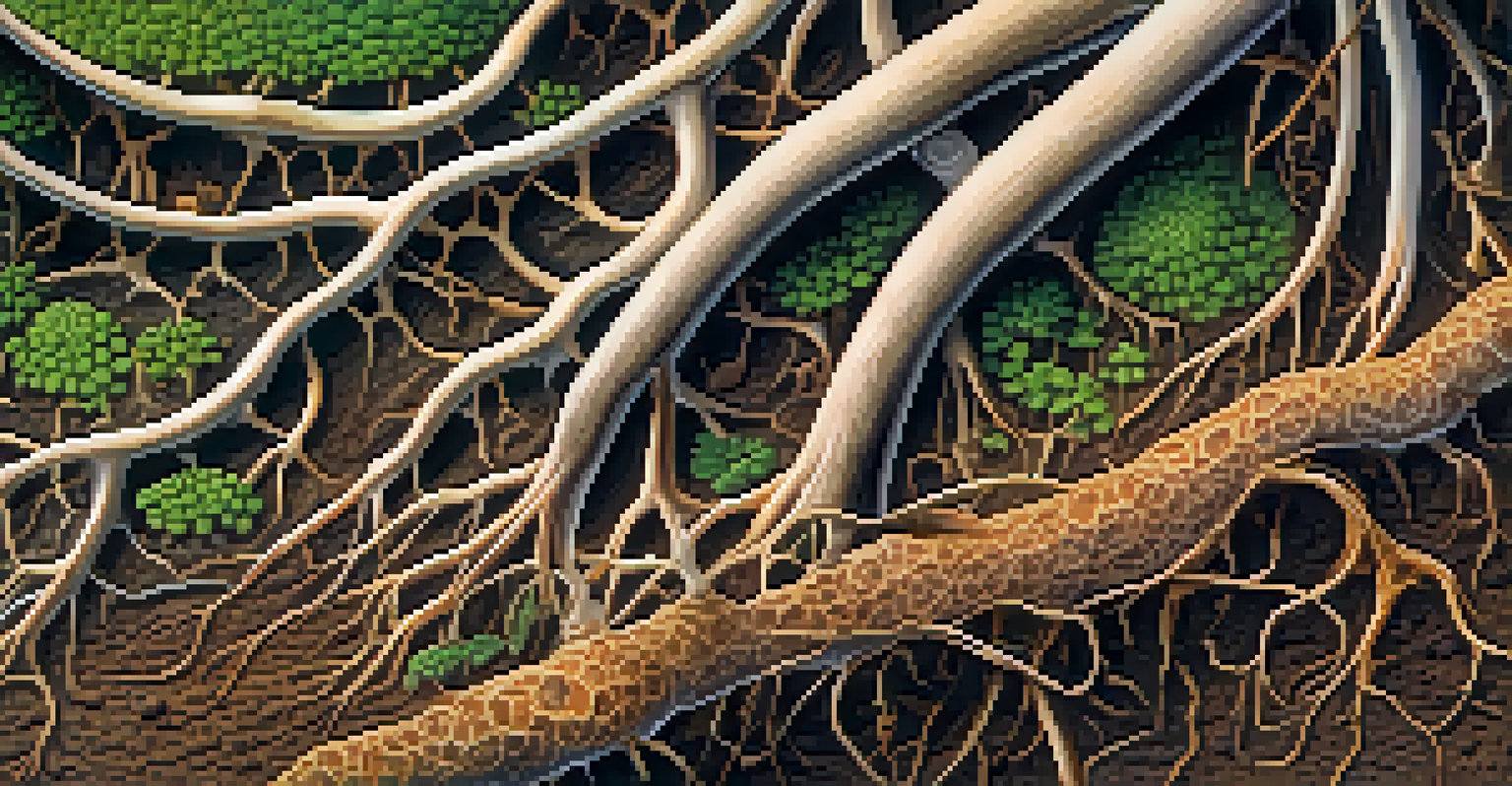Deciphering the Complex Relationship Between Fungi and Roots

The Basics: What Are Fungi and Plant Roots?
Fungi are fascinating organisms that play a crucial role in ecosystems. They belong to their own kingdom, separate from plants and animals, and are known for their unique structure, including hyphae and mycelium. On the other hand, plant roots serve as the anchor and nutrient uptake system for plants, absorbing water and essential minerals from the soil. This foundational understanding sets the stage for exploring their complex relationships.
Fungi are the great recyclers of nature, playing a vital role in nutrient cycling and soil health.
Both fungi and plant roots are vital to soil health and ecosystem balance. Roots not only support plants but also provide a habitat for various microorganisms, including fungi. In turn, fungi contribute to soil structure and nutrient cycling, making them essential partners in the natural world. This interdependence highlights the significance of their relationship in maintaining ecological stability.
In the grand tapestry of life, fungi and roots are interconnected threads that weave together to support diverse ecosystems. Their relationship is not merely one of coexistence but of collaboration, showcasing nature’s ingenious ways of forming bonds that benefit all involved. Understanding this relationship helps us appreciate the complexity of life beneath our feet.
Mycorrhizal Fungi: The Champions of Plant-Fungi Relationships
Mycorrhizal fungi are among the most well-known and studied types of fungi in relation to plant roots. These fungi form symbiotic associations with the roots of most plants, creating a network that enhances nutrient uptake. Through this partnership, plants receive vital nutrients like phosphorus and nitrogen, while fungi gain sugars produced by the plants through photosynthesis.

This mutualistic relationship exemplifies cooperation in nature. For instance, studies have shown that plants with mycorrhizal partners often grow healthier and stronger, demonstrating how fungi can improve plant resilience to environmental stressors. This collaboration is not just beneficial; it’s essential for the survival of many plant species in nutrient-poor soils.
Fungi and Roots: A Vital Partnership
The interdependent relationship between fungi and plant roots is essential for nutrient uptake and overall soil health.
The significance of mycorrhizal fungi extends beyond individual plants; it affects entire ecosystems. By facilitating nutrient exchange, these fungi contribute to the overall health of the soil, supporting a diverse range of plant life. This interconnectedness illustrates how vital mycorrhizal networks are in sustaining both flora and fauna within various habitats.
The Role of Ectomycorrhizae in Forest Ecosystems
Ectomycorrhizae are a specific type of mycorrhizal fungi that form a protective sheath around plant roots, primarily in forest ecosystems. This relationship is particularly crucial for trees, as ectomycorrhizae enhance their ability to absorb water and nutrients from the soil. In doing so, they help trees thrive in often harsh and competitive environments.
In nature, nothing exists alone; the interdependence between plants and fungi exemplifies the intricate web of life.
For example, many tree species, such as pines and oaks, rely heavily on ectomycorrhizae for their growth and development. The fungi not only supply essential nutrients but also improve the tree's resistance to pathogens and environmental stressors. This partnership showcases the intricate balance of forest ecosystems, where each species plays a role in supporting the other.
Moreover, ectomycorrhizae contribute to soil health by promoting organic matter decomposition, which in turn enriches the soil. This process supports a diverse array of life forms within the forest, from insects to larger wildlife, highlighting the importance of fungi in maintaining ecological harmony. Their presence is a testament to nature’s interconnectedness and symbiotic relationships.
Endomycorrhizae: The Hidden Helpers Beneath the Surface
Endomycorrhizae, unlike their ectomycorrhizal counterparts, penetrate the root cells of plants, forming a close relationship that enhances nutrient uptake. This type of mycorrhizae is particularly important for many herbaceous plants and crops, making it a significant player in agriculture. By improving nutrient absorption, endomycorrhizae help plants grow more robustly, which is crucial for food production.
A classic example of endomycorrhizal fungi is the genus Glomus, which is widespread in agricultural soils. These fungi help crops access nutrients like phosphorus and potassium, which are often limited in soil. Farmers who understand and utilize the benefits of endomycorrhizae can enhance soil health, leading to more sustainable agricultural practices.
Mycorrhizal Fungi Enhance Growth
Mycorrhizal fungi form beneficial associations with plants, improving their resilience and nutrient absorption in various ecosystems.
In summary, endomycorrhizae are unsung heroes in the plant kingdom, working quietly beneath the surface to support plant health. Their role in enhancing nutrient uptake not only benefits plants but also contributes to overall ecosystem health. This hidden partnership underscores the importance of recognizing and valuing the often unseen relationships that drive life on Earth.
Fungi and Roots: A Dynamic Interaction for Soil Health
The relationship between fungi and roots goes beyond simple nutrient exchange; it plays a vital role in maintaining soil health. Fungi help create soil aggregates, which improve soil structure and aeration. This is crucial for root growth and water retention, allowing plants to flourish even in challenging conditions.
Moreover, fungi contribute to the decomposition of organic matter, recycling nutrients back into the soil. This process not only enriches the soil but also fosters a diverse community of microorganisms that further support plant health. The dynamic interaction between fungi and roots creates a thriving ecosystem that benefits all living organisms within it.
In essence, the collaboration between fungi and roots is a cornerstone of healthy soil ecosystems. By working together, they enhance biodiversity, promote resilience against environmental challenges, and sustain plant life. Understanding this dynamic interaction helps us appreciate the intricate web of life that supports our planet.
Challenges Faced by Fungi-Root Relationships
Despite their many benefits, fungi-root relationships face significant challenges in today’s world. Environmental changes, such as climate change and pollution, can disrupt these delicate partnerships. For example, increased soil acidity or nutrient runoff can hinder fungal growth and their ability to interact with plant roots effectively.
Additionally, agricultural practices that rely heavily on synthetic fertilizers can negatively impact these relationships. While fertilizers provide immediate nutrients, they can disrupt the natural processes that fungi and roots rely on, leading to a decline in soil health over time. This highlights the importance of sustainable practices that encourage natural partnerships.
Challenges to Fungi-Root Interactions
Environmental changes and unsustainable agricultural practices pose significant threats to the delicate relationships between fungi and plant roots.
As we continue to face global challenges, understanding and preserving the relationship between fungi and roots becomes crucial. By fostering these connections, we can promote healthier ecosystems and more sustainable agricultural practices. Protecting these partnerships is not just about saving fungi or plants; it’s about ensuring the health of our planet.
The Future of Fungi-Root Interactions: A Path Forward
Looking ahead, the future of fungi-root interactions holds exciting possibilities for both agriculture and ecology. Research into these relationships is expanding, revealing new insights into how we can harness their benefits. For instance, sustainable farming practices that promote mycorrhizal fungi can lead to healthier crops and reduced reliance on chemical fertilizers.
Moreover, initiatives aimed at restoring natural ecosystems often emphasize the importance of fungi in promoting plant growth. By understanding the role of fungi in soil health, conservation efforts can become more effective, creating resilient ecosystems. This shift towards recognizing the value of fungi is essential for long-term environmental sustainability.

Ultimately, fostering a deeper understanding of fungi-root interactions can lead to innovative solutions for global challenges. By prioritizing these relationships, we can create more sustainable agricultural systems, restore degraded lands, and enhance biodiversity. The path forward lies in recognizing the intricate connections that sustain life on Earth.